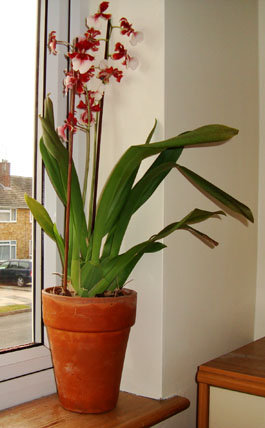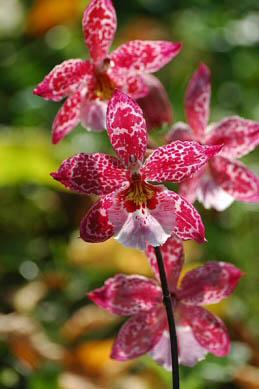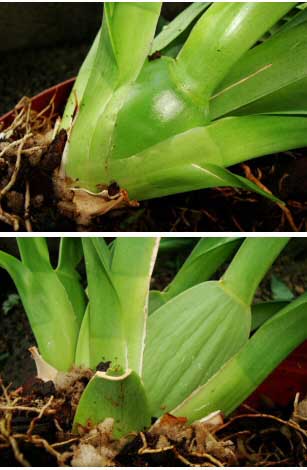





The Cambria or Vuylstekeara Orchid is quite unusual because unlike most house plants it does not grow naturally out in the wild, instead it was created in a lab in 1911 by Charles Vuylsteke. This is unusual because almost all  plants that exist indoors today have been collected from the wild and then cultivated for indoor use in order to suit our needs and changing fashions.
plants that exist indoors today have been collected from the wild and then cultivated for indoor use in order to suit our needs and changing fashions.
Vuylstekeara can be called and labeled as a Cambria (which is a broad name used to cover many different Orchid crosses) or a Vuylstekeara. The Vuylstekeara was produced from several other Orchid Alliances, namely Odontoglossum, Cochlioda, Miltonia, Oncidium and Brassia. In simple terms this Orchid is essentially a cross or a intergeneric hybrid of other plants. It will therefore have elements that resemble both it's "parents" and may be difficult to identify as a result.
Despite its very varied, exotic, long lasting and often scented flowers, Vuylstekeara is still quite uncommon commercially and you will certainly have to search it out from a specialist if you want one. You may get lucky with a large garden centre or nursery but it would be very unlikely to be in stock all year round. If you find this plant and you like it snap it up, although as you might expect with rare plants it comes with an expensive price tag.
If treated well you can expect this Orchid to flower every 9 months or so as this is roughly how long it takes for a pseudobulb to complete it's growth cycle. You usually only get one flowering stem from each pseudobulb so it's normal to buy a large "clump" which is actually several separate plants potted up together (which is another reason they can be pricey).
Light
Most Orchids are shade-loving and this is also true for Vuylstekeara therefore you should keep it away from direct sunlight. On the other hand they still need good light to do well, a North or East facing window should be perfect.
Watering
You will normally buy the plant with a loose, airy and open growing medium. This is essential as Vuylstekeara will not stand for saturated soils. The open growing medium has the effect of producing a very free draining mix and this is how it should be. Water really well around once a week (more in very hot conditions and less when it gets colder) and ensure that the water is allowed to escape from the container to prevent the Orchid roots sitting in water.
Humidity
High levels of humidity will produce a thriving plant. Although if you can't, Vuylstekeara is usually still accommodating, but you may need to water slightly more often.
Feeding
When feeding orchids do so little and often rather than a lot infrequently
With such an open growing medium it's far too easy to wash out any nutrients it holds, be prepared to fertilise every third or fourth watering, but you must use a very weak solution. Little and often rather than a lot infrequently.
Temperature
Orchids tend to fall into three growing types, Cool-growing, Intermediate-growing or Warm-growing. Vuylstekeara belongs in the Cool-growing group, which is ranged between 10°C - 30°C / 50°F - 86°F. Clearly that is a wide range in temperatures so treat this as the Minimum and Maximum and try to stay around the middle if possible. If you slip outside of these ranges the Orchid will become stressed and may lose vigor.
Repotting
There should be no hurry to repot Vuylstekeara, it grows slowly, usually only one pseudobulb per year. If you look closely you will notice with each new pseudobulb it moves closer to the edge of the pot, therefore it will only need repotting either when the plant becomes unstable and starts to tip over, or when it reaches the actual edge. Our Moth Orchid repotting instructions can be followed for this task .
Propagation
Propagating your Vuylstekeara / Cambria orchids is rather difficult and holds a risk so should not be undertaken lightly. Some house plants will allow you to simply cut them in half and thereby giving you two plants. Orchids which have pseudobulbs are different because once the most recent one is replaced with a newer one in the "chain", it rapidly looses its ability to grow another replacement pseudobulb. It's a bit like some garden plant seeds which quickly lose the ability to germinate the longer they are left in their little foil packets.
If you go ahead with a propagation attempt you need to remove the most recently formed pseudobulb as soon as it matures, which leaves the one behind it to hopefully grow a replacement. If no new growth is created then the old plant will have been ruined (the gamble). Meanwhile you should pot up the removed pseudobulb in a similar potting mix to the parent plant. The risk here is that this pseudobulb has to cope without the support of the older "back bulbs" and consequently may not survive by itself.
If you are fortunate and you are able to create two new plants then expect there to be a longish break before either portion flowers again.
Speed of Growth
You will get rapid bursts of growth, then long periods of not much happening. This is entirely normal for almost all Orchids.
Height / Spread
The final height (excluding flowering stem) and eventual spread will be around 50cm / 19in.
Flowers
The flowers of Vuylstekeara are both graceful and delicate looking. Coming in many different colours and shapes they will last several weeks or even a month or two if temperatures are reasonably cool.  Many have an exquisite fragrance, although they will not be powerful enough to fill a room like say a Hyacinth in bloom would.
Many have an exquisite fragrance, although they will not be powerful enough to fill a room like say a Hyacinth in bloom would.
The flowering stem in good light conditions will shoot straight up, but as they can be double the height of the plant they may need a little support to stay upright. You can gentle insert some support canes and attach the flowering stem to them using some butterfly or Orchid clips. Be careful though, whilst flexible they will still snap if you are too rough with them.
Each pseudobulb will only flower once, so as soon as the blooms fade you should remove them from the flowering stem which will eventually brown up and die. At this point cut the flowering stem off as it doesn't have any further purpose.
There is not a set time when Vuylstekeara's flower. The pseudobulb growth cycle takes about 9 months to complete, so with good care the plant should on average rebloom every 9 months.
What's a Pseudobulb and how do they work?
The inside of a pseudobulb contains a great deal of fibrous material that can store a remarkable amount of water, nutrients and sugars created by photosynthesis to support the plant and future pseudobulb's in times of drought.  After many years the old pseudobulb starts to weaken and the leaves which are growing from it will gradually brown and fall off, leaving a "back bulb". You can remove these when you repot the Orchid as they are no longer supporting the remainder of the "clump" in any great capacity.
After many years the old pseudobulb starts to weaken and the leaves which are growing from it will gradually brown and fall off, leaving a "back bulb". You can remove these when you repot the Orchid as they are no longer supporting the remainder of the "clump" in any great capacity.
The top photo on the right shows a fresh plump, new pseudobulb from which a flowering spike will eventually form. The bottom photo shows two old pseudobulb's, one has lost its leaves and will eventually brown and "die", the other has become skinny and winkled as the energy it once stored is gradually being depleted.
Many Orchids produce pseudobulb's which create a sympodial type of growth, this is where a new one is added to the plant each "season". This allows the Orchid to build a series of pseudobulb's that form a chain, new growth comes from an "eye" at the base of the previous pseudobulb. Often several "eyes" are present but only one (or sometimes two) results in new growth. The idea being that if the new growth is damaged then one of the other eyes might activate, giving the plant a second chance. This is the hope when you try to propagate.
The growth will eventually mature and become the new leading pseudobulb. A flowering stem will emerge, after which it will produce "eyes" from which new growths will be created and the cycle starts again. In this way Orchids with pseudobulbs have the ability to renew themselves and live to a very old age or in theory, forever. The cycle for a Vuylstekeara takes around 9 months and the plant will continue to prosper and grow for years to come.
Copyright © www.100flowers.win Botanic Garden All Rights Reserved